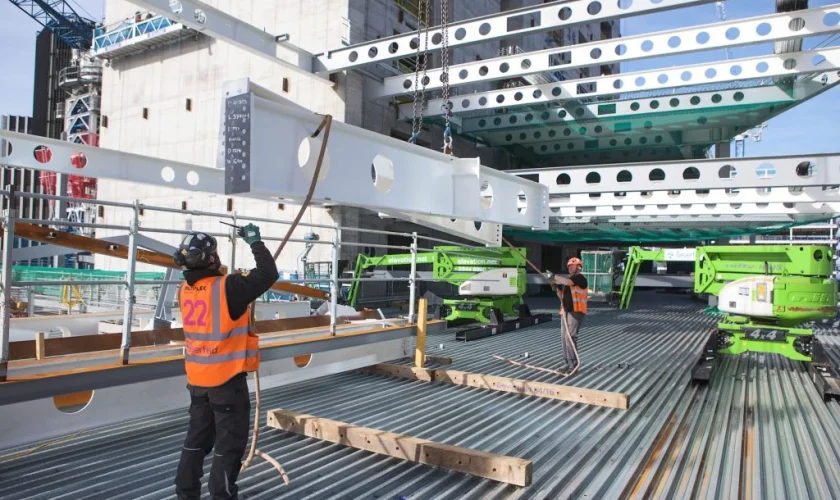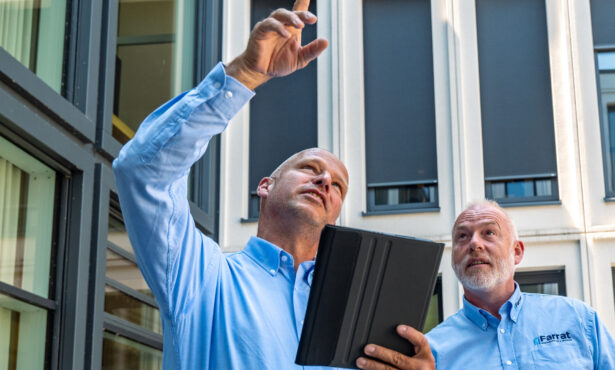It has been widely shared that buildings and construction are responsible for almost 40% of global carbon emissions driving rapid climate change.
But, did you know that at the current rate of construction, the world is forecast to build more than 2 trillion square feet of floor space in the next 40 years? In their current form, a considerable proportion of these buildings will be constructed out of concrete, with cement as its main ingredient (a notorious greenhouse gas emitter).
A simple route to reducing carbon emissions in the race to net-zero is to design and build smarter. By this, we mean reducing the volume of materials required in construction, reusing/repurposing where possible, and opting for high-performance materials with superior efficiency credentials at the point of the specification.
This sentiment is echoed in a recent report published by the Royal Academy of Engineering on ‘Decarbonising Construction’, which notes that the following aspects will be vital in achieving net-zero transformation in the construction sector:
- availability and specification of low-carbon materials,
- reusing materials as standard,
- and low-carbon procurement.
In our latest insight below, we further explore the role of sustainable building materials in the built environment to understand how our Structural Thermal Break solutions align with the agenda.
Utilising sustainable building materials in construction
Reduce, recycle and reuse
Structural steelwork and lightweight gauge steel can be recycled and reused multiple times. As a result, steel is increasingly selected as a reliable material for constructing robust structures that meet the low carbon demands of the future without compromising on design, practicality, or cost-efficiency.
The recovery rates from demolition sites in the UK are 99% for structural steelwork and 96% for all steel construction products – figures that far exceed those for any other construction material. And the superior strength-to-weight ratio of steel as a construction material, also means that a little goes a long way. This unique characteristic gives steel a high economic value at all stages of its life cycle.
By utilising more recyclable building materials, the industry contributes to more sustainable development by reducing waste and by saving primary resources. Recycling materials such as steel and other metals also save energy and reduce carbon emissions, since it requires less energy to re-melt scrap than it does to produce new metal from primary resources, i.e., iron ore.

BHC steelwork erection at Cineworld Hounslow in 2019
The primary benefits of recycling sustainable building materials are well understood and include:
- Reducing waste, i.e., diverting waste from landfill
- Saving primary resources, i.e., substituting primary production
- Saving energy and associated greenhouse gas emissions through less energy-intensive reprocessing.
Although these benefits apply to many commonly recycled materials, there are some significant differences in the properties of materials that influence the environmental benefit of recycling and particularly how these benefits are quantified.
Metals, for example, are infinitely recyclable, i.e., they can be recycled repeatedly into functionally equivalent products – this is the most environmentally beneficial form of recycling.
Other products are ‘down-cycled’ into new products that are only suitable for lower grade applications because the recycled product has different, usually lower, material properties. Although waste is diverted from landfills by down-cycling, only lower-grade primary resources are saved.
For example, crushing bricks and concrete for hardcore, sub-base, or general fill saves aggregates but does not save the resources required to make new bricks or new concrete.
BHC steelwork erection at Cineworld Hounslow in 2019
For recycling to be sustainable in the long term, it is important that the recycling process is financially viable. This is frequently the biggest hurdle to recycling, particularly for products and materials that are downcycled into lower grade, low-value applications.
Current end-of-life scenarios for three of the most common construction materials; concrete, timber and steel are shown below. The illustration describes the end-of-life outcomes of these materials against the established UK Waste Hierarchy.
Moving towards more sustainable procurement
Steel production is currently a source of greenhouse gas emissions (7% in 2020); however, the good news is that a revolution in steel production is now within reach.
The amount of energy used in steel manufacture has fallen by some 61% since the 1960s, according to World Steel Association data (2020), and further improvements are being sought from steel sector research and development investments.
In 2020, 1.8 gigatons (GT) of steel were produced, accounting for 90% of all metals globally. Major steel-producing countries, including China, Japan, the EU, and now the US, have set ambitious targets to reach net-zero economies. Achieving these demands will further advance the material efficiency of steel and the greater recycling of scrap steel.
In 2005, the British Constructional Steelwork Association (BCSA) became the first steel representative organisation in the UK to launch a Sustainability Charter. This was updated and strengthened in 2021 in response to the climate emergency. The objective of the Charter is to further advance steel as a sustainable form of construction in terms of carbon reduction, reuse and efficiency, economic viability, social progress, and environmental responsibility.

Severfield installing steel connections with Farrat TBK Structural Thermal Breaks at 22 Bishopsgate, London
Similarly, leading manufacturers and suppliers of structural steel in the UK, British Steel, and Tata Steel, are certified under the BRE Environmental & Sustainability Standard BES 6001, a responsible sourcing certification for the UK construction market.
For these companies, sustainable procurement is part of wider corporate responsibility.
Severfield installing steel connections with Farrat TBK Structural Thermal Breaks at 22 Bishopsgate, London
Thermal efficiency in modern steel design
In respect of the energy efficiency of buildings constructed with steel, low and zero-carbon buildings, and buildings with high BREEAM ratings are readily achievable using steel construction.
Structural Thermal Breaks are commonly integrated into primary and secondary steel connections as high-performance thermal insulators that provide a robust solution to minimising energy loss in steel construction.
Performance characteristics of Farrat thermal break materials include low thermal conductivity, high compressive strength, and limited creep under load, which provides Steel Contractors and Structural Engineers with complete flexibility to modify typical structural steel details with confidence, without compromising thermal efficiency or conformance.
And unlike general thermal insulation materials on the market, Farrat Structural Thermal Breaks are suitable to mitigate against planar, linear, and point load thermal bridging whilst carrying structural loads, which means that they can be used anywhere a penetration or transition exists in a building envelope, helping Architects and designers to achieve the highest levels of building performance and energy standards.
Thermal efficiency credentials
Passive House is one of the highest standards for energy efficiency, granting certification to structures, components, and professionals who have achieved and designed the best in quality, efficiency, and sustainability. The criteria to gain the title of ‘Certified Passive House Component’ is based on two categories: living health and comfort (‘Comfort criteria’) and energy balance during practical application (‘Energy criteria’).
In 2019, Farrat’s high-strength Structural Thermal Break material Farrat TBK, was listed as a Certified Passive House Component by the Passive House Institute in recognition of its low thermal conductivity and superior energy efficiency performance.
Following this in 2020, Farrat’s A2 non-combustible fire-rated Structural Thermal Break material, Farrat TBF, was entered as an approved product into the BRE (Building Research Establishment) Certified Thermal Details and Products Scheme and was also awarded BBA (British Board of Agreement) certification.
The BRE is an international independent certification body, operating with the highest standards in the certification of fire, security, and environmental products and services, management processes, and other products and systems. Details provided within the BRE scheme are invaluable to building design professionals committed to creating energy-efficient structures and are especially useful for architects and structural engineers at the specification stage.
BRE Certified Thermal Details for both Farrat TBK and Farrat TBF thermal breaks are available online here.
We have always placed a strong emphasis on impartial assessment and certification for our structural thermal break materials. It enables us to back up our commitment to creating cutting edge materials with practical value and sustainability, for buildings and structures of the future.
says Chris Lister, Commercial Manager of Structural Thermal Breaks at Farrat.
Summary
Specifiers and contractors are responsible for addressing some of the biggest challenges facing the building construction industry in the race to net-zero.
Meeting these challenges head-on in terms of innovative energy efficiency, intelligent building design, and responsible sustainable building materials choices will be a key driver in reaching sustainability targets and safeguarding the future of the world.
For more information on integrating thermal break solutions into typical, or bespoke, structural steel connections, visit our Structural Thermal Break hub or one of our dedicated portals.
#onamission









